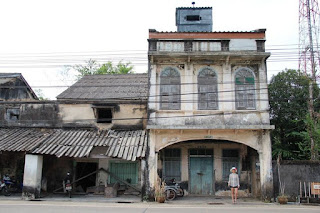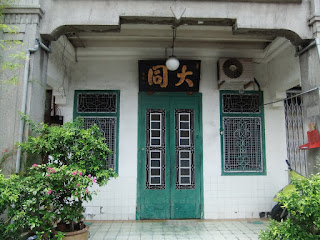In regards to the Chinese, it is a question that has occupied this present writer since arriving in South-East Asia many months ago and travelling through the historical centres of the Straits Chinese, that being the Chinese (mainly from the southern regions of China) who, centuries ago, migrated to various parts of the Malacca Straits. The prosperous state of Singapore is the most outstanding instance of their success, but in other places too – Penang, Phuket, southern Thailand – they have been remarkably successful. In Malaysia, more than a few people the author encountered told him candidly that “The Chinese are the brains of the outfit.” They are a minority in Malaysia, and increasingly uncomfortable in the face of creeping Islamization in that country, yet, despite the odds, their history has been illustrious and they are more successful in business, arts, law – every field – than the native Malays. The Malays resent this, but the fact of the matter is that without the straits Chinese Malaysia would, very likely, become a second-rate affair.
In Siam, further up the peninsula, it is a similar story. The Chinese element constitutes some 40% of the population – this element, and not the ethnic Thais alone, constitutes the real genius of the place. The Chinese came for trade and tin mining. They stayed and, somehow, have become disproportionately prosperous. Wherever they go, the Chinese make a profound contribution. Those places from which they have been chased away, as the author has also seen – Calcutta and Cochin in India, for example, both of which once boasted thriving Chinese populations which are now departed – are that much poorer without a Chinese dynamic.
No doubt, much depends upon a capacity for hard work. The Chinese work like dogs. But there are other factors, surely, as well. One of them seems to be a great capacity for the creative appropriation of elements from other cultures; this, and an unfailing sense of what is and is not essential in their own. The author has been witness to examples of this throughout his travels among the Straits communities in the form of so-called Sino-Portuguese architecture. This is the style of architecture that the Straits Chinese created in their new home and in which they built monuments to their industry, success and prosperity. Shop-houses – also called “link houses” – are the most common example of Sino-Portuguese architecture to be seen, but the Chinese magnates and tycoons who grew fabulously rich on trade in the Malacca Straits built mansions and palaces in this style as well. Many of them are still intact and ,happily, many private residences are now open for public viewing.
The term “Sino-Portuguese” is not entirely appropriate, or at least the “Portuguese” part of it is not. Sure enough, the Portuguese were among the first Europeans to arrive and establish a presence in South-East Asia, but in fact they had little direct impact upon the hybrid architectural styles of the area. The Dutch, French and even more so the English make a greater contribution. All the same, the word “Portuguese” became attached to this particular architectural hybridization, and in this sense it merely means “European” inasmuch as Europeans in general were referred to as “Portuguese”. Thus, “Sino-Portuguese” actually means no more than “Chinese slash European”, being a style created by the Chinese by combining elements of traditional Chinese domestic architecture with what they came to learn of various European styles, borrowing and adapting those features they saw fit. The maturity of the synthesis, moreover, did not come about until the late XIXth century – long, long after the Portuguese had disappeared from Asia, and in fact under the fullest expansion of the British Empire. Actually, the heyday of the style was the 1920s, and the fine examples still to be seen in such places as George Town and Phuket Old Town are from that illustrious period.

So-called 'link houses' - or what are in Australia called 'terrace houses'. Single-fronted, two storey buildings. The ground floor was usually used as a shop or workshop with the upstairs for bedrooms and living space. They are narrow but deep and feature an interior air well.
This page, below, offers a short folio of examples of the Sino-Portuguese style. The style is a particularly charming synthesis and illustrates the creative powers of adaptation typical of the Straits Chinese. This is an architecture that documents exactly how the Chinese of the Malacca Straits were able to establish themselves as such extraordinarily succesful communities. One characteristic deserves comment. Despite their minority status, and despite a history of oppression and discrimination, resentment does not figure prominently in the Chinese psychology. They are not a people burdened, for instance, with post-colonial angst. Unlike others, they looked upon Europeans with admiration and a determination to acquire those things worth acquiring. In this, as noted above, they were unshakeably secure in their own cultural and religious identity. They did not feel that acquiring the benefits brought by Europeans in any way threatened or compromised their own traditions and identity. This same unshakeable security is typical of the Jews as well. Regardless of how much they acquire of non-Jewish societal norms, their own religious and ethnic identity remains unthreatened. This sense of security is a prerequisite to creative appropriations.

We see the fruits of such self-security in the Chinese in the Sino-Portuguese style. It is confidently Chinese and regardless of how much it acquires from European styles it never compromises on this. Compare this to those peoples who have spent decades whining and moaning about "colonial oppression" without achieving much of anything. The Chinese know that the best way to defeat your oppressors is to be succesful. Nothing succeeds like success. This architecture is a testament to that strategy, above all.

The Sino-Portuguese architecture of the Staits Chinese communities is unquestionably some of the most charming and elegant architecture in Asia. It is no accident that it is the product of a happy blend of oriental and occidental styles. As elsewhere, much of it is now surrounded by modernist cement monstrosities underlining the sad fact that little architecture of any consequence has been built since before the Second World War.

The Sino-Portuguese architecture of the Staits Chinese communities is unquestionably some of the most charming and elegant architecture in Asia. It is no accident that it is the product of a happy blend of oriental and occidental styles. As elsewhere, much of it is now surrounded by modernist cement monstrosities underlining the sad fact that little architecture of any consequence has been built since before the Second World War.


The link houses in Soi Romani (Love Lane) in Phuket Town. Previously brothels, now boutique guesthouses and coffee shops.




























No comments:
Post a Comment